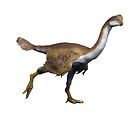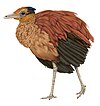南鳥屬
| 南鳥屬 | |
|---|---|
| 科学分类 | |
| 界: | 动物界 Animalia |
| 门: | 脊索动物门 Chordata |
| 纲: | 鸟纲 Aves |
| 目: | †维加鸟目 Vegaviiformes |
| 科: | †维加鸟科 Vegaviidae |
| 属: | †南鳥屬 Australornis Mayr & Scofield, 2014 |
| 模式種 | |
| 拉氏南鳥 Australornis lovei Mayr & Scofield, 2014
| |
南鳥屬(學名:Australornis)是維加鳥科的一個屬,生存年代為距今6150萬–6060萬年前的古新世達寧期,約在6500萬年前的白堊紀﹣古近紀滅絕事件發生後不久[1],其化石出土於紐西蘭南島坎特伯雷區北部的威帕拉綠沙化石床(Waipara Greensand)[2][3]。本屬的學名來自拉丁文的南方(australis)與希臘文的鳥類(ornis),僅包含Australornis lovei一種,其種小名為紀念發現發現其化石的業餘考古學家Leigh Love[1][4]。
南鳥屬是紐西蘭出土的古新世鳥類化石中第一件不屬於企鵝目者[4],不屬於任何現生鳥類類群[5],其出土也有重要的動物地理學意義,因白堊紀晚期至古新世早期西蘭大陸尚未被淹沒,紐西蘭與南極洲距離較今日接近許多,本屬的化石應是在西蘭大陸外海海床中形成[4]。
發現
[编辑]2009年,業餘考古學家Leigh Love在紐西蘭南島坎特伯雷區北部的威帕拉綠沙化石床(Waipara Greensand)發現了南鳥屬的化石[2],與已知最古老的企鵝化石威馬奴企鵝屬出土的地點和年代接近,但南鳥屬並無與企鵝相似之處[3]。出土的化石部位包括右側喙突、右側肩胛骨、右側肱骨、右側尺骨以及橈骨的碎片等[1],由基督城的坎特伯雷博物館保管[4]。2014年,森根堡自然博物館的考古學家傑拉爾德·梅爾與坎特伯雷博物館的保羅·史考菲(Paul Scofield)描述發表了此化石,其體長約為70–85公分,體重可能介於1.5–2公斤之間[5]。
分類
[编辑]2017年,Agnolín等人的種系發生學研究將南鳥屬、極地鳥屬、維加鳥屬等歸入維加鳥科,為雁形類(Anserimorph)的基群[6],但梅爾對此分類提出質疑,認為尚無足夠證據將南鳥屬歸入維加鳥科中[7]。
參考文獻
[编辑]- ^ 1.0 1.1 1.2 Mayr, G; Scofield, RP. First diagnosable non-sphenisciform bird from the early Paleocene of New Zealand. Journal of the Royal Society of New Zealand. 2014, 44 (1): 48–56. doi:10.1080/03036758.2013.863788.
- ^ 2.0 2.1 One of the world's oldest flying seabird fossils discovered in North Canterbury. Canterbury Museum. 22 January 2014 [17 March 2014]. (原始内容存档于2014-03-19).
- ^ 3.0 3.1 Ancient seabird fossil found in New Zealand already 'like modern birds'. Birdwatch.co.uk. 26 Jan 2014 [17 March 2014]. (原始内容存档于2016-03-04).
- ^ 4.0 4.1 4.2 4.3 O'Connor, Sarah-Jane. Fossil discovery sheds light on unknown bird. The Press. Fairfax Media. 22 January 2014 [17 March 2014]. (原始内容存档于2017-10-09).
- ^ 5.0 5.1 58-Million-Year-Old Flying Seabird Discovered in New Zealand. Sci-News.com. 27 January 2014 [17 March 2014]. (原始内容存档于2019-12-15).
- ^ Agnolín, F.L.; Egli, F.B.; Chatterjee, S.; Marsà, J.A.G. Vegaviidae, a new clade of southern diving birds that survived the K/T boundary. The Science of Nature. 2017, 104 (87): 87. PMID 28988276. doi:10.1007/s00114-017-1508-y.
- ^ Mayr, G.; De Pietri, V.L.; Scofield, R.P.; Worthy, T.H. On the taxonomic composition and phylogenetic affinities of the recently proposed clade Vegaviidae Agnolín et al., 2017 ‒ neornithine birds from the Upper Cretaceous of the Southern Hemisphere). Cretaceous Research. 2018, 86: 178–185. doi:10.1016/j.cretres.2018.02.013.























